
One of the most important tactical benchmarks at any fire scene is establishing a sustainable and reliable water supply. What is even more desirable is for that water supply to not only meet the current fire flow requirements but exceed the needed fire flow should a strategic shift take place.
A fire department’s investment in 6-inch soft suction is the most efficient and effective way to add flexibility to engine company personnel who routinely operate from fire hydrants.
Before going any further into the benefits of 6-inch soft suction on pumping apparatus, it is extremely important to understand exactly what the term “6-inch soft suction” means. The reference to 6-inch soft suction means that we are using soft, flexible fire hose rated as either “attack” or “supply” hose that is no more than 25 feet in length. Any mention in this article of 6-inch, 6-inch soft suction, or 6-inch hose is referring to soft, flexible fire hose that is 6 inches in diameter and no more than 25 feet in length.
I am by no means advocating for departments to replace their entire 4-inch or 5-inch supply beds with 6-inch hose; rather, purchase one 25-foot section per rig (photo 1). Departments that make this simple acquisition will quickly see the benefits on the fireground. The use of 6-inch hose when operating as the supply pumper will quickly yield higher fire flows from fire hydrants while simultaneously increasing the effectiveness of “less desirable” intakes as well as preferred intakes.

1 This engine carries one 25-foot length of 6-inch soft suction that is preconnected to the front intake and stored in the center tray. This enables the apparatus to easily position and quickly deploy the 6-inch soft suction sleeve. (Photos by author.)
Hydrants and 6-Inch Soft Suction
Most driver/operators are extremely familiar with the use of 6-inch hard suction for drafting operations. When we are talking about 6-inch soft suction, however, we are almost exclusively using them for connecting to fire hydrants. Flow from a fire hydrant is completely dictated by the residual pressure remaining in the municipal system to move water through the water mains, hydrant, fire hose, and apparatus plumbing. We all recall from our basic hydraulics class that large-diameter hose (LDH) is capable of moving larger volumes of water because of a reduction in friction loss. But why is 6-inch hose so phenomenal? After all, aren’t 4-inch and 5-inch considered LDH?
The majority of modern dry barrel fire hydrants are connected to the main that feeds them using 6-inch pipe. The upper barrel of the hydrant that the 6-inch pipe connects to can be anywhere from 4½ to 5¼ inches in diameter.1 Simply put, when using 6-inch soft suction connected to the steamer port of the hydrant, our supply hose is equal in diameter to the branch or lateral that connects the hydrant to the main. The choke point and, therefore, the limiting factor in the setup is the actual barrel diameter of the hydrant itself—either 4½ or 5¼ inches.
Obviously, the best way to achieve high fire flows from a fire hydrant is to use LDH connected to every outlet on the hydrant, or “dress” the hydrant (a discussion for another article). Whether your department does not carry the necessary gate valves to achieve this hydrant setup or its culture does not believe in the advantages of this setup, 6-inch hose is the best way to set your operators and rigs up for larger fire flows.
The use of 6-inch hose ensures that, at the very least, the hose you connect to the steamer port of the hydrant will be equal in diameter to the pipe that connects the hydrant to the main. The limiting factors that will affect the flow will then be the barrel diameter of the hydrant and the actual diameter of the main feeding the hydrant.
4- and 5-Inch Hose vs. 6-inch Hose
Some may be wary of the idea of using 6-inch hose for supply operations. After all, the biggest complaint about 5-inch supply line tends to be how heavy and difficult it is to move and pick up. We will not debate this fact; however, it is important to compare apples to apples. When we talk about the use of 6-inch hose, we specifically mean a section of 6-inch hose that is no more than 25 feet in length. Although a 25-foot length of 6-inch hose when charged weighs just more than 300 pounds, we don’t normally tend to move this hose once it is in place because it is hooked from the steamer port on the hydrant to an intake on the engine. With 4- or 5-inch hose, the need to move several hundred feet of supply line laid down a street to enable other apparatus access to the scene is a very real possibility.
The biggest advantage of using 6-inch hose for supply pumper operations is the tremendous reduction in friction loss compared to 4- and 5-inch hose. When compared to 4-inch hose, 6-inch supply lines have roughly 75% less friction loss per 100 feet at the same flow rate.2 When we compare the friction loss characteristics of 5-inch hose with those of 6-inch hose, we see that 6-inch hose has approximately 40% less loss per 100 feet and at the same flow rate2 (Tables 1 and 2).


The reduction in friction loss of the supply hose is of extreme importance for supply pump operators. As stated earlier, fire hydrants rely on the residual pressure in the municipal system to deliver their rated flow. Hydrants are rated to flow their maximum capacity while maintaining a residual pressure of 20 pounds per square inch (psi) in the system.1 By using 6-inch hose connected to the steamer connection, less pressure is lost from friction compared to 4- or 5-inch hose. This results in a higher residual intake pressure on the master intake gauge of the pump. A higher residual pressure means one of two things to the pump operator: (1) More water is available for firefighting operations and the current flow rate can be increased; or (2) if the flow rate does not need to be increased, the pump does not have to work as hard to deliver the current volume of water—more residual intake pressure means less pressure the pump has to build.

2 The use of the front intake on this fire enabled the supply pumper to position out of the way of later-arriving aerial apparatus. The 6-inch soft suction allowed for quickly establishing water while also providing superior flow capabilities compared with its 4-inch counterpart.
So 6-inch soft suctions increase the efficiency of supply pumpers by either increasing the total volume that the pumper can deliver or reducing the work load on the rig. This is primarily because of the tremendous reduction in friction loss compared to the traditional supply hoses used.
6-Inch Soft Suctions and Front Intakes
There is often a hot debate when it comes to the use of front intakes and large-flow operations. Front intakes historically have tremendous amounts of loss in their plumbing configurations. This is because of the multiple angled bends in the pipe leading from the front of the apparatus to the pump. This coupled with the use of less-than-ideal supply hose leads to very undesirable fire flows.
With this being said, front intakes do offer advantages to the supply pump operator. First and foremost, the front intake is arguably the easiest intake on the apparatus to position the rig for. It has often been said, “If you can’t spot the rig for the front intake, you shouldn’t be driving.” Positioning the apparatus for the front intake can also enable the operator to put the engine up on the sidewalk or farther off the road when making the hydrant connection. The biggest advantage of this maneuver is that it allows for other apparatus to access the scene (photo 2).
Many departments purchase apparatus equipped with front intakes but are then hesitant to use them because of the hydraulic loss in the plumbing configurations. When 6-inch hose is used on a front intake, we are capable of achieving higher flow rates compared with using 4- or 5-inch hose on these intakes. Since 6-inch hose has 75% less friction loss compared to 4-inch hose and 40% less than 5-inch hose, more pressure is available to overcome the hydraulic loss in the plumbing of the front intake. Once an apparatus is delivered and put in service, we have no way of changing the hydraulic loss characteristics of the front intake plumbing. However, using 6-inch hose connected to our front intake reduces the pressure loss from the hydrant outlet to the front intake, which results in higher residual intake pressures.
To illustrate this, the following tests were performed to compare the effects of using 4-inch soft suction on a front intake vs. 6-inch soft suction. The goal of the tests was to determine the residual intake pressure for a given flow rate when the only variable changed was the diameter of the hose connected to the front intake. The following variables remained constant throughout each test:
- The same pumping apparatus was used for both tests.
- The same flow rate of 1,000 gallons per minute (gpm) was used for both tests.
- The tests were performed on the same day, one after the other.
- The same hydrant was used for both tests.
- Both test pieces of hose were the same length; the only variable was the hose diameter.
The first evolution tested a 25-foot length of 4-inch supply line connected to the front intake. The target flow rate of 1,000 gpm was achieved, and a residual intake pressure of approximately 25 psi was recorded (photos 3 and 4).

3 This department formerly used 4-inch soft suction sleeves for front intake connections. Here, the rig is flowing 1,000 gpm through the front intake with a residual intake pressure reading of 25 psi.
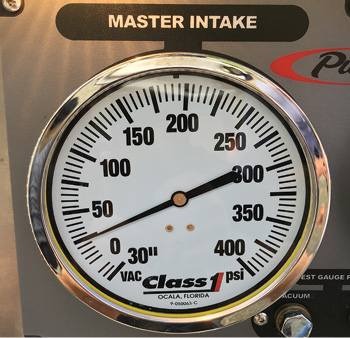
4 The residual intake pressure during the test where 4-inch soft suction was hooked to the front intake.
The next evolution involved testing a 25-foot length of 6-inch supply line connected to the front intake. Again, the target flow rate of 1,000 gpm was achieved; however, the residual intake pressure recorded was 35 psi (photos 5 and 6). This is a 40% increase in the residual intake pressure compared with the 4-inch line! The use of 6-inch soft suction on front intakes allows the supply pumper to position at the best advantage, leaving room for other apparatus while simultaneously providing higher residual intake pressures compared to other types of supply lines.

5 When the 4-inch soft suction was switched out for the 6-inch soft suction, our 1,000-gpm flow rate was achieved with a residual intake pressure of 35 psi. This 10-psi increase from the previous test shows a 40% improvement compared with the 4-inch supply line.
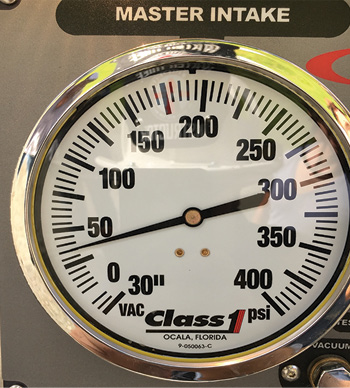
6 The residual intake pressure reading during the test where the 6-inch soft suction was hooked to the front intake.
6-inch Soft Suctions and Main Intakes
If your department is looking to achieve very high fire flows with minimal plumbing loss, using 6-inch soft suction connected to the driver or passenger’s main intake is the gold standard. As mentioned before, front intakes have a considerable amount of hydraulic loss contained within them. Although front intakes tend to be easier to position for, their loss characteristics make them less than ideal to some operators. On the contrary, side or main intakes generally have the least amount of hydraulic loss because their plumbing runs straight to the impeller.
Using 6-inch hose with a side intake will yield the highest available fire flows when only one supply line is connected to the hydrant. The best way to think of this is that we are connecting our biggest hose with the least amount of loss to our best intake, which also has minimal loss. The result is even higher residual intake pressures on the master intake gauge. As mentioned earlier, higher residual intake pressures mean that either more water is available or the pump can provide the desired volume of water without working as hard.
The one disadvantage to a driver or passenger side intake is that it can be somewhat difficult to position for on tight streets. This is mainly because when positioning for a side intake, the operator usually has to park the apparatus farther off the hydrant to prevent the supply line from kinking. When using supply lengths that are only 25 feet long, this compounds the issue (photo 7). These circumstances inevitably result in a scenario where the supply pumper is positioned in such a way that it impedes the access of other apparatus—primarily, later-arriving truck companies.

7 In an effort to position for the driver’s side main intake, this apparatus was forced to stay farther off the curb. This resulted in the apparatus having a larger profile in the roadway. It also increased the probability of kinks. Since the hydrant outlet and pump intake are fixed objects, the supply line will be the object that moves and thus kinks.
One option for allowing the supply pumper to position out of the way but still reach the hydrant connection is to use 50-foot lengths of soft suction. This may be realistic when using 4-inch supply lines, but a 50-foot length of 6-inch soft suction becomes too cumbersome to manage. Remember, the ideal length for our 6-inch soft suction is 25 feet. A 25-foot section of 6-inch hose is easily manageable to deploy and does not take up a tremendous amount of space on the rig. However, our problem still remains: How do we stay out of the way of other rigs, reach the hydrant with 6-inch hose, and not have any kinks in the line?
The solution is an appliance commonly known as a “90-degree drafting elbow” (photo 8). Now, despite the name, most manufacturers of 90-degree drafting elbows construct them to withstand hydrant pressures. By using the 90-degree elbow, the engine operator is able to position the apparatus by getting the bumper as close to the hydrant as realistically possible. The 6-inch supply line can then be connected to the hydrant and arced to the 90-degree elbow, which connects to the side intake. This virtually eliminates any kink potential (photos 9 and 10).
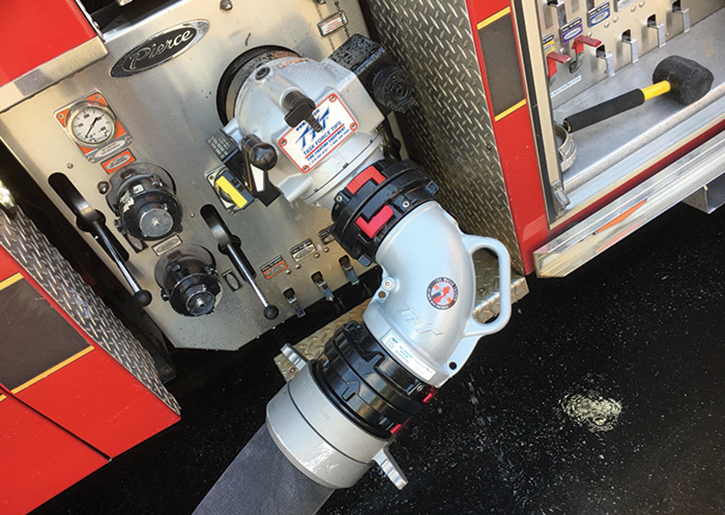
8 A 90-degree elbow helps to eliminate any kinking issues the operator may experience when trying to arc the supply line to the hydrant.

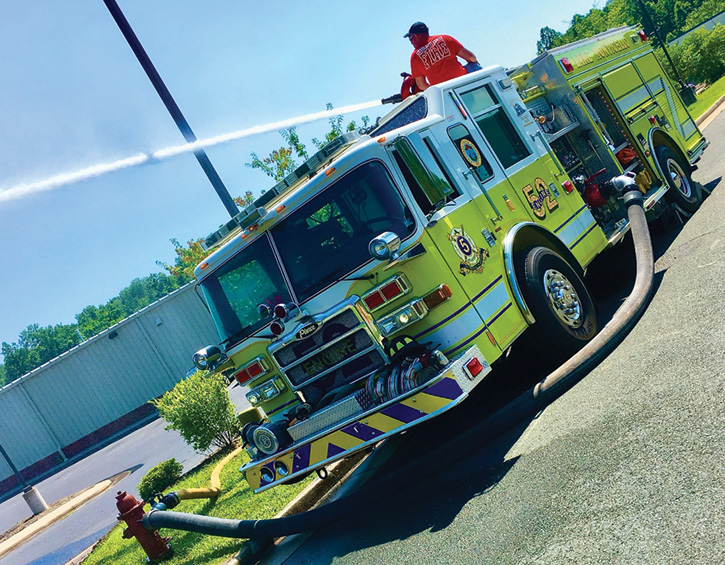
9, 10 These engines are using 90-degree drafting elbows in conjunction with 25-foot 6-inch soft suctions to reach their side intakes. This maneuver allows the rigs to stay close to the curb while providing superior flow capabilities.
It is important to remember that the goals of any water supply operation should be functionality and efficiency. The use of a 90-degree elbow with a section of 6-inch soft sleeve enables the supply pumper to position functionally to allow other apparatus access. It also enables the supply pumper to use its best piece of supply hose to connect to the hydrant, which maximizes efficiency by yielding higher fire flows.
Some argue that the use of the 90-degree elbow still isn’t desirable because it naturally contains hydraulic loss within it. While this is true, it is certainly less than the combined loss of any front intake plumbing. To demonstrate this, we performed another test similar to the ones described earlier. This test followed the same conditions as above; the only difference was now the 6-inch soft sleeve was connected to the driver’s main intake with a 90-degree elbow. The target flow rate of 1,000 gpm was achieved, and the residual intake pressure was recorded as 45 psi (photo 11). This is an 80% increase in residual intake pressure compared to the 4-inch connected to the front intake! This test also demonstrated a 28% increase in residual pressure compared to having the 6-inch connected to the front intake of the rig (Table 3)!
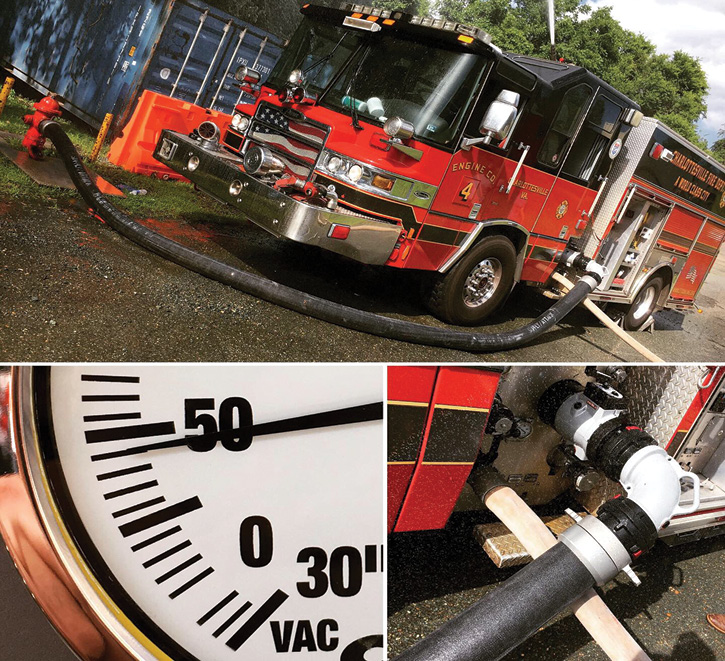
11 Results of the final test scenario where the 6-inch soft sleeve was connected directly to the driver’s main intake using a 90-degree elbow.
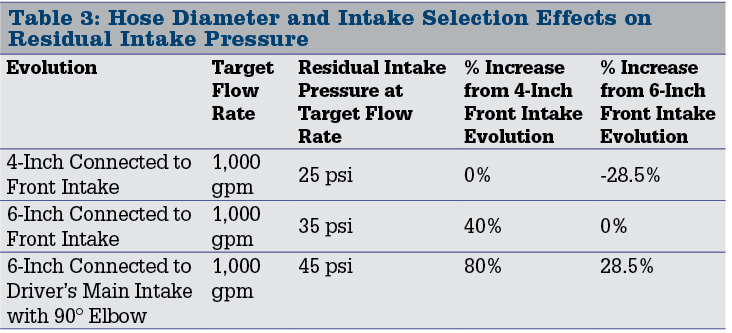
The use of 6-inch soft suction hose has a tremendous impact on the functionality and efficiency of the modern engine company. Since the majority of modern fire hydrants are connected to the water main that feeds them with 6-inch pipe, using 6-inch soft suction creates an extension of this pipe. The only limiting factor becomes the hydrant’s barrel size—usually either 4½ or 5¼ inches in diameter.
The 6-inch hose inherently has much lower friction loss characteristics when compared to its 4- and 5-inch counterparts. These reduced friction loss values result in higher residual intake pressures at the pump. The higher residual intake pressures will yield either higher flow capabilities or less work needed by the pump to deliver the flow required.
When 6-inch hose is used with front intakes, it enables pump operators to reap all the positioning advantages that front intakes provide while simultaneously increasing the flow potential through the intake. For very large flow needs, a 25-foot length of 6-inch hose can quickly and efficiently be hooked from a hydrant to the main intake of the engine with the use of a 90-degree elbow. This will result in the highest flow potential from the hydrant when only one hose connection is made. These characteristics of 6-inch hose make it one of the most functional pieces of equipment on any supply pumper.
ENDNOTES
1. American Water Works Association, Hydrants, A. S. C. F., & Association, A. W. W. (2006b). Installation, Field Testing, and Maintenance of Fire Hydrants, 4th Ed. Denver, CO: American Water Works Association.
2. Crapo, W. F. (2015). Chapter 6 Friction Loss. In Fire Protection Hydraulics and Water Supply (Third Edition, pp. 86-89). Burlington, MA: Jones & Bartlett Learning.
Andy Soccodato, a 14-year veteran of the fire service, is a firefighter and driver/operator with the Charlottesville (VA) Fire Department. He has served as a driver/operator for both career and volunteer fire departments on both engine and truck companies. He is the owner of The Water Thieves, LLC, a training business that specializes in delivering street smart driver/pump operator courses.

